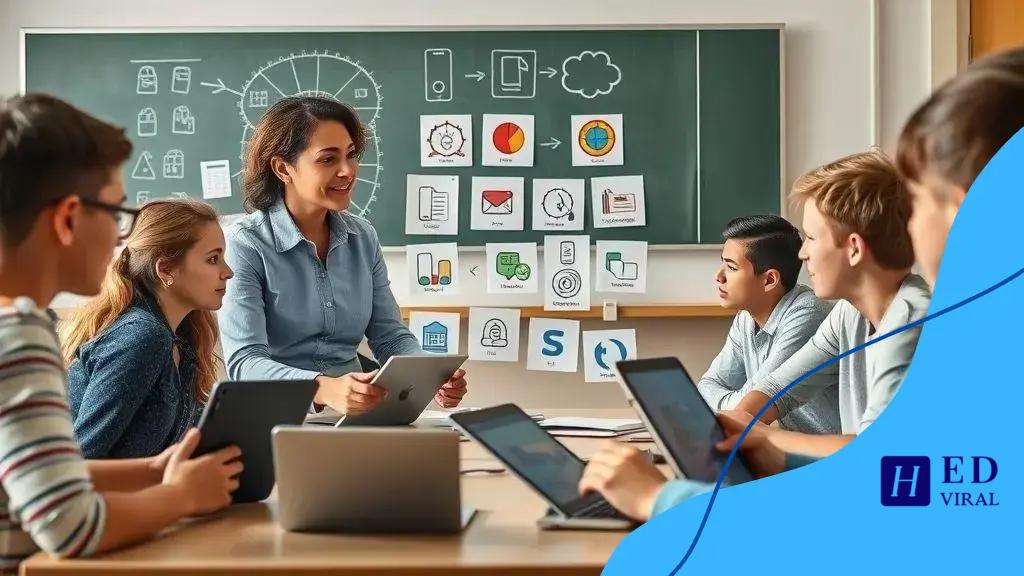Digital classroom tools: transform how students learn

Digital classroom tools enhance the learning experience by providing personalized learning environments, integrating technologies like virtual reality, and increasing student engagement through interactive elements.
Digital classroom tools are changing the way we think about education. Have you ever wondered how these technologies can reshape learning experiences? In this article, we’ll dive into the variety of tools available and their impact on student engagement.
Understanding digital classroom tools
Understanding digital classroom tools is essential for teachers and students today. These tools are designed to enhance the learning experience, making it more interactive and engaging. By implementing these resources, educators can facilitate better communication and collaboration among students.
What are Digital Classroom Tools?
Digital classroom tools encompass a variety of technologies used in education. They include software, applications, and hardware that assist in teaching and learning.
Types of Digital Classroom Tools
- Learning Management Systems (LMS): Platforms that manage course materials, assessments, and student interactions.
- Interactive Whiteboards: Displays that allow teachers to present lessons interactively.
- Video Conferencing Tools: Applications that enable live classes and discussions from different locations.
- Collaboration Tools: Software that encourages group projects and communication.
Each of these tools offers unique benefits, enhancing the classroom environment. For example, an LMS can streamline course content delivery, while video conferencing tools can connect classrooms across the globe.
Additionally, digital classroom tools support various learning styles. Visual learners can benefit from interactive presentations, while auditory learners can engage through video and audio formats. This flexibility helps meet the diverse needs of students.
Why Use Digital Classroom Tools?
The use of digital classroom tools has grown significantly due to their capacity to improve learning outcomes. They allow for personalized learning, where students can progress at their own pace, and provide immediate feedback to both instructors and learners.
Moreover, these tools promote engagement by incorporating multimedia elements, making lessons more enjoyable. Teachers can track student progress with ease, adjusting their teaching methods based on real-time data. This adaptability is crucial in today’s fast-changing educational landscape.
In conclusion, understanding digital classroom tools can significantly impact the effectiveness of teaching and learning. By leveraging these technologies, educators can create dynamic, supportive learning environments that cater to all students.
Benefits of using digital classroom tools
The benefits of using digital classroom tools are numerous and wide-reaching. These tools enhance both teaching and learning experiences. By integrating technology into the classroom, educators can create a more engaging environment.
Enhanced Engagement
One significant advantage is the boost in student engagement. Digital classroom tools like interactive whiteboards and multimedia presentations capture students’ attention better than traditional methods.
Improved Collaboration
Another benefit is the ability to foster collaboration among students. With tools like online discussion boards and group projects via shared platforms, students can work together easily, even outside the classroom.
- Access to Resources: Students have access to a vast array of learning materials online.
- Foster Creativity: Digital tools allow students to express their ideas through various formats.
- Instant Feedback: Educators can assess student understanding in real-time and give immediate support.
The flexibility of these tools is a major plus. They accommodate different learning styles, allowing visual, auditory, and kinesthetic learners to thrive. For instance, a video presentation may resonate well with visual learners while podcasts may be better suited for auditory types.
Another notable benefit is the development of critical skills. Students learn to navigate technology, communicate effectively, and work collaboratively. These skills are essential for success in today’s job market.
Personalized Learning
With digital classroom tools, personalized learning becomes more achievable. Teachers can tailor assignments to meet individual student needs, providing options that match different skill levels.
This focus on personalization empowers students to take ownership of their learning, setting their own pace and goals. Thus, technology not only aids in knowledge acquisition but also builds confidence.
How to choose the right tools

Choosing the right digital classroom tools is crucial for enhancing student learning and engagement. With so many options available, it’s important to identify which tools best meet the specific needs of your classroom. This process can streamline teaching and create a more interactive learning environment.
Identify Your Goals
Start by defining what you want to achieve. Are you looking to improve collaboration, facilitate remote learning, or enhance student engagement? Knowing your goals helps narrow down your choices. For instance, if your focus is on collaboration, tools that support group projects and communication should be prioritized.
Evaluate Features and Compatibility
Next, evaluate the features of potential tools. Look for those that offer:
- User-Friendly Interfaces: The tools should be easy for both teachers and students to navigate.
- Integration: Check if the tool can integrate with your existing systems, like LMS or student management software.
- Support and Resources: Consider the availability of tutorials or customer support to assist with onboarding.
Compatibility with different devices is also important. Ensure that the tools can be accessed on various platforms, whether it’s a tablet, computer, or smartphone.
Consider Student Needs
Every classroom has diverse student needs. When selecting digital classroom tools, keep these aspects in mind. Some tools may cater to specific learning styles, while others might provide additional support for students with disabilities.
Engage students in the selection process as well. Gather their feedback on what features they find valuable. This can help ensure that the chosen tools will be used effectively and embraced by learners.
Trial and Feedback
Before fully integrating any tool, it may be useful to run a trial period. Allow teachers and students to experiment with the tools and provide feedback. This will help determine their effectiveness and suitability for your classroom environment.
Incorporating digital classroom tools into the learning process can greatly enhance educational experiences. By carefully considering goals, features, and student needs, you can select the right tools that foster a dynamic learning atmosphere.
Implementing tools in the classroom
Implementing digital classroom tools in the classroom can transform the learning experience for both students and teachers. To ensure a smooth integration, it’s important to follow a strategic approach. This process involves several key steps that can lead to successful utilization of technology in education.
Start with Training
Before introducing any tools, it’s essential to provide proper training for teachers. Understanding how to use the tools effectively helps educators feel more confident. Workshops and training sessions can showcase features and best practices for integrating the tools into daily lessons.
Set Clear Expectations
It’s important to set clear expectations for both teachers and students regarding how and when to use digital classroom tools. Establish guidelines for participation, assignments, and communication. This will create a structured environment and help students understand their roles.
Create a Support System
Creating a support system is vital for troubleshooting and assistance. Establish a tech support team or designate a teacher who is proficient with technology. This person can assist others in navigating any challenges that arise during the implementation process.
- Encourage Feedback: Gather feedback from both students and teachers to improve the implementation process.
- Adjust Strategies: Be flexible and willing to adjust the use of the tools based on feedback and results.
- Celebrate Success: Acknowledge successes and celebrate milestones in the integration journey.
Continuous evaluation of the tools is also critical. Monitor how effectively the tools are being used, and assess their impact on student learning and engagement. Regularly reviewing the tools allows for better decision-making on whether to continue using them or seek alternatives.
Lastly, encourage collaboration among students while using these tools. Projects that require teamwork can enhance critical thinking and social skills. Engaging with peers through digital classroom tools promotes a more interactive learning atmosphere.
Future trends in digital classroom technology
The future of digital classroom technology is bright and full of exciting innovations. As technology continues to evolve, classrooms are likely to become more interactive and engaging than ever before. This transformation will enhance the learning experience for students and make teaching more effective.
Personalized Learning Experiences
One major trend is the move towards personalized learning. With advancements in artificial intelligence, we can expect tools that adapt to each student’s learning style and pace. These tools will analyze student performance in real-time and adjust lessons accordingly.
Virtual and Augmented Reality
Another exciting development is the integration of virtual and augmented reality (VR/AR) in classrooms. These technologies will provide immersive learning experiences, allowing students to explore historical sites, conduct science experiments, or engage in interactive simulations without leaving the classroom.
- Real-World Applications: VR can take students on virtual field trips, making learning more engaging.
- Enhanced Engagement: AR can overlay digital information on real-world objects, creating interactive lessons.
- Collaborative Experiences: Students can work together in virtual environments, enhancing teamwork skills.
In addition, the use of gamification in education is expected to rise. Gamified learning platforms make studying more fun by incorporating game-like elements. Students are more motivated to learn when they can earn points, badges, or rewards.
Data-Driven Insights
The future of digital classroom technology will also involve a greater reliance on data. Educators will use analytics to gain insights into student performance and engagement. This will help identify which strategies work best, leading to improved teaching methods.
Furthermore, remote and hybrid learning options will become more refined. As schools have adapted to changes in recent years, the combination of in-person and online learning is likely to continue. This flexibility allows students to learn in ways that best suit their needs.
Lastly, cybersecurity in educational technology will become increasingly important. With more digital tools being used, schools must prioritize the safety and privacy of student information. Ensuring secure platforms will build trust and encourage more schools to adopt innovative technologies.
FAQ – Frequently Asked Questions about Digital Classroom Technology
What are digital classroom tools?
Digital classroom tools are technologies used to enhance teaching and learning, including software and hardware like learning management systems, interactive whiteboards, and collaboration applications.
How can personalized learning benefit students?
Personalized learning allows students to learn at their own pace and in ways that best suit their learning styles, which can lead to improved engagement and achievement.
What role does virtual reality play in education?
Virtual reality (VR) offers immersive learning experiences that can transport students to different environments, such as historical sites or scientific labs, enhancing understanding and retention of information.
Why is data privacy important in digital education?
Data privacy is crucial to protect students’ personal information and maintain trust. Educational institutions must ensure that digital tools comply with privacy regulations to safeguard student data.






